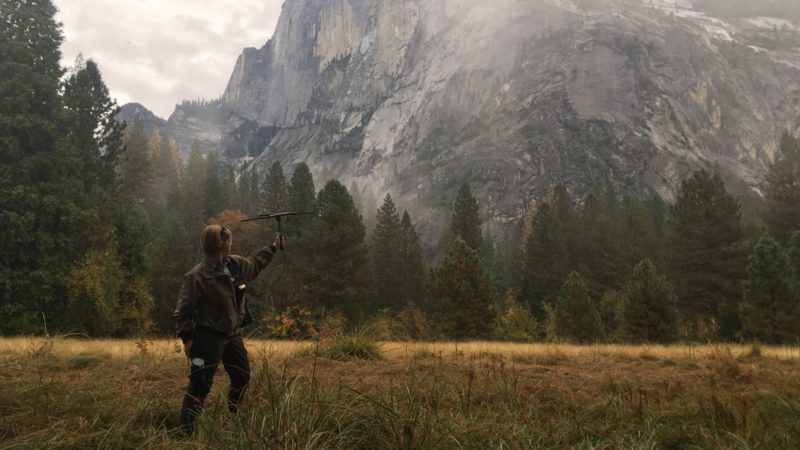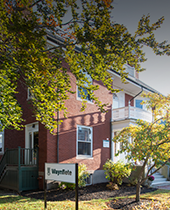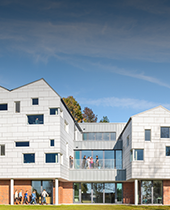From the Wilds of Yosemite National Park
I am writing this letter from a cabin in Yosemite Valley, where my windows overlook – in one direction – an oak grove with four giant Sequoias shedding dark orange and brown leaves on the gravestone of Galen Clark, and in the other, impatient rainclouds haloing the tallest waterfall in the continental united states.
I am so lucky to have lived the adventures I have over the past six and a half years – And I can honestly say that I have Waynflete to thank for every one of them. My eight years with Waynflete taught me the value of community, and of asking questions. It taught me how to write, but also how to experience emotion and understand the nuances of the written word. It taught me the scientific method and the theory of tragedy of the commons; but it also planted in me the understanding of systems and the connectivity of science and ecology to the vast array of pressing problems our world is facing. It taught me about complimentary colors and photo composition, but also how to create an image or a graphic design that can move people to tears, or even to action. It taught me to dance freely, to stand up for what I believe, and to pursue my dreams and give them space to grow.
I am speaking about Waynflete like an entity, but of course, it is the people who did this for me – teachers, staff, and my peers, friends, and loved ones at Waynflete (you know who you are). It was the community.
Upon graduating, I left the haven of my oceanside community for the gorges, farmland, and farmers markets of Ithaca New York. I studied Natural Resources at Cornell University, which posed a unique set of challenges, but also opened many doors. I spent my years delving into lofty ideas like permaculture, agroecology, social and environmental justice, and food waste diversion. I studied abroad in a cloud forest in Costa Rica, where I learned about the lenses through which I see the world as well as globalization and imperialism. I studied abroad at Findhorn Ecovillage in Scotland, where I learned the nuances, challenges, and possibilities of using community and human connection to create change. I helped lead a course exploring economic alternatives to copper mining in Ecuador. During the summers I stuck around New York, working one summer as a technician capturing and radio-collaring black bears, one as an environmental educator, and one as a youth garden coordinator and a playworker with an adventure playground.
When I graduated, I threw caution to the wind, left behind everything I knew, and flew out to the Sierra Nevada to live in a three-person tent and chase black bears out of campgrounds using a paintball gun. This was the first time I had set foot in a national park; and the three months I had been planning on spending in Yosemite turned to six as my heart melted into the interplay of sunlight, granite, and ponderosa. Bear management is (because of hibernation) seasonal in nature, and after I had extended my time here for as long as was reasonable (“…Don’t you think this picnic table could use a mural?”) I had to leave for the winter.
This brought me to the startlingly cool experience of helping start up the L.A. Urban Coyote Project (NPR member story). This fired up a passion in me for citizen science and community based wildlife management, and I stayed with the Santa Monica Mountains NPS team for nine months, radio-tracking coyotes through downtown L.A. at 3 in the morning, managing a corps of 30 or so citizen scientist “scat collectors”, and hosting monthly coyote scat-dissection parties in the city which Angeleños flocked to in droves. The city provided rich and diverse opportunities studying urban wildlife, but my heart had never really let go of Yosemite – So, about 13 months ago, I came back.
In the fall, I chased around bears. When they went into hibernation, I finally found myself in a position to use my art to try to change the world, and I shifted to being a full time art volunteer for the park service. I worked primarily on an educational adult coloring book for the park, which I am still working on—it turns out, creating books is REALLY hard—as well as some graphic design for the Yosemite Conservancy, including a shirt that’s now for sale [90% of proceeds go to the Conservancy which is the organization supporting a vast majority of research and progress within Yosemite, 10% directly into a bear education account].
In the spring, my three seasons of volunteering for the NPS finally paid off (though they were well worth every minute even as I lived them!), and I was hired as a paid Biological Science Technician running a field study on raccoons and river otters in Yosemite Valley. I radio collared and tracked raccoons, managed a bunch of wildlife cameras, and trained a corps of citizen scientist “otter observers” to search the Merced riverbanks for otter tracks and sign.
Now, as the winter comes close, I have decided again to stay in this wild and striking place which is increasingly becoming my home; and I will be helping run the Yosemite social media presence over the winter, in a time where I feel that this role is highly relevant and one where I may be able to make some difference.
It is hard to know where my path will go from here; and looking back, I never could’ve imagined being where I am today. I know that I have always valued living in the moment. Every marine biology field trip, every day of spirit week, every poem I workshopped, every time I ordered toast and coffee at the café, every dance performance, every notecard I wrote, every science olympiad tournament, every homeroom—that moment, as I lived it, was the most important thing I had ever done, and each of those moments prepared me in ways I never knew were possible for all of the future moments I’m living in now. I think I can attribute where I am today to living in the moment, working hard at everything I have decided to do, and following the things that bring me joy and fulfillment every time, even when they were scary or hard.
Looking back, after living and studying in so many places, and having worked with thousands of inspirational people and some of the best minds in their fields—Waynflete is completely unique. There is nowhere in the world that I have seen that holds space for the same level of community, and that fosters the desire to learn, that seeds a passion for discovery and creativity, the way Waynflete did for me.
So thank you.
And to all the students lucky enough to be ‘Fleters today, and to the teachers who (clearly; if you’re reading this) changed my life in immeasurable ways. It’s amazing to see Waynflete continuing to respond to a constantly changing political and education climate in progressive and loving ways. It has been so affirming to see Waynflete in the news continuing to create it’s own identity through the years as a community for learning and a haven for respect and creative space for children to grow and become their unique, beautiful, complete selves.
I’d always be happy to speak to any students interested in getting into the wildlife field or the park service; email me at or shoot me a Facebook message.
Thanks for everything Waynflete. Keep on changing lives. 🙂
Love,
Binta Wold





